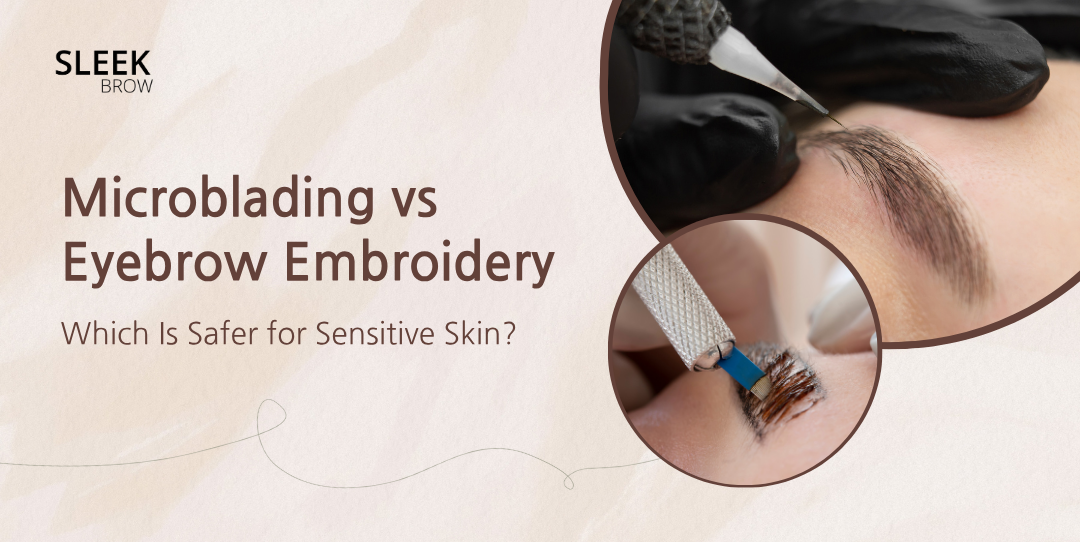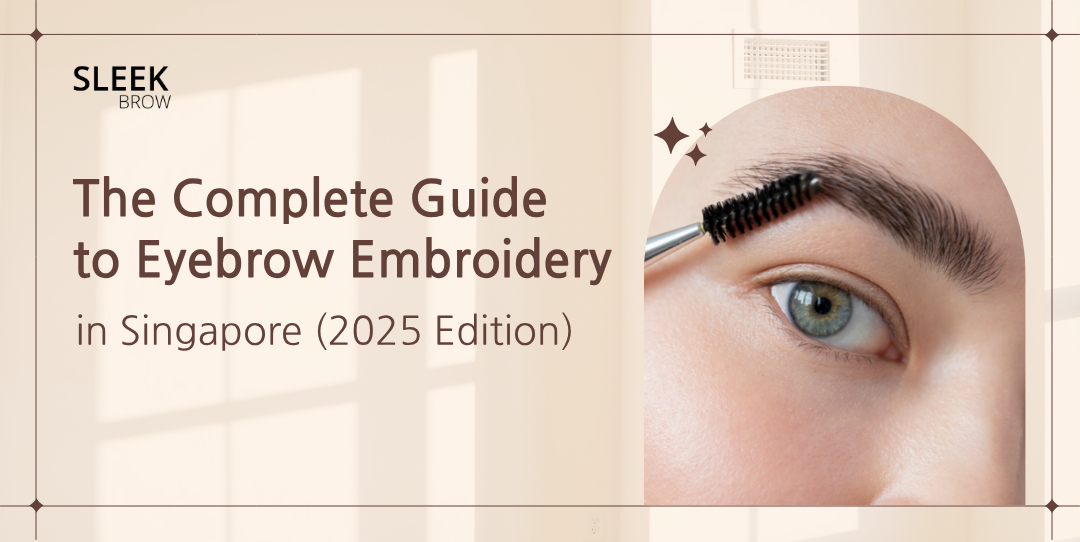If you’re comparing eyebrow embroidery vs microblading and have sensitive skin, chances are you’re worried about redness, irritation, or an allergic reaction that lingers for weeks.
And you’re right to be cautious, sensitive skin reacts differently, and not every brow technique is created equal.
Let’s walk through what truly sets these two techniques apart, which one is safer for delicate skin types, and how to prepare (and care) for your brows before and after the procedure.
No myths, no fluff, just clear, skin-smart facts.
Understanding the Difference Between Microblading and Eyebrow Embroidery
| Factor | Microblading | Eyebrow Embroidery |
| Tool Used | Manual blade with micro-cuts | Ultra-fine digital needle, with the use of machine |
| Skin Penetration | Deeper into dermis | Controlled within epidermis |
| Pain & Redness | Higher, creates open micro-wounds | Lower, minimal irritation |
| Healing Time | 10 to 14 days, with dramatic healing and scabbing | 7 to 10 days, smoother recovery, less dramatic healing |
| Pigment Retention | May fade faster on sensitive skin | More stable, lasts 18 to 24 months |
| Best For | Normal, thicker skin | All skin type including thin, sensitive, or reactive skin |
Summary:
Microblading cuts; embroidery deposits.
Less trauma = better results for delicate skin.
When it comes to eyebrow embroidery vs microblading, the distinction goes far beyond a trendy name.
They’re completely different methods and understanding how each works is key to protecting sensitive skin.
Microblading uses a manual handheld blade.
Your artist makes tiny cuts to implant pigment into the skin, think of it as sketching individual hair strokes with micro-incisions.
The result looks natural, but those cuts are still tiny wounds, which can be harsh for fragile or reactive skin.
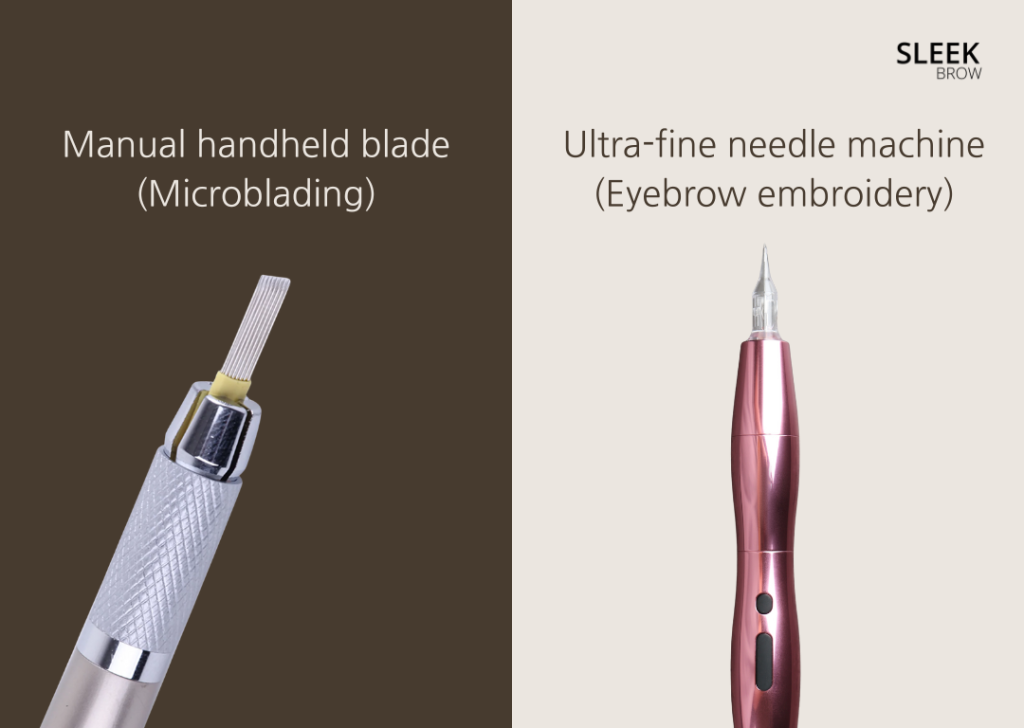
Eyebrow embroidery, on the other hand, uses an ultra-fine needle machine.
Instead of slicing, it gently punctures the skin at a controlled depth, allowing pigment to be deposited with precision and minimal trauma.
The technique can mimic hair strokes or soft shading, depending on your preferred finish.
Here’s how that matters for sensitive skin:
- Microblading cuts deeper into the dermal layer, causing more skin trauma
- Eyebrow embroidery needles can be adjusted to stay within the epidermis, less disruption, faster recovery
- Healing is quicker, with minimal scabbing and less risk of inflammation
- Pigment sits more evenly and tends to last longer without harsh fading
When it comes to eyebrow embroidery vs microblading, the gentler approach wins every time, and that’s embroidery.
Why Sensitive Skin Reacts Differently
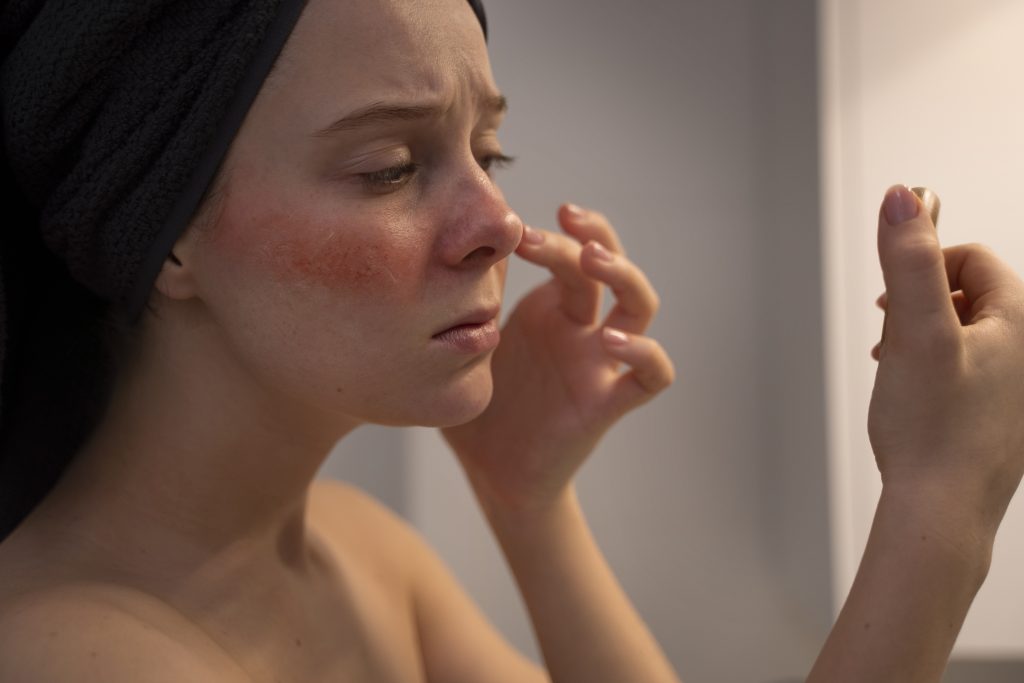
Sensitive skin has a thinner barrier and heightened immune response.
During brow tattooing:
- Blood flow and inflammation increase rapidly.
- Redness and swelling last longer.
- Pigment retention becomes unpredictable.
Typical sensitive-skin reactions include:
- Lingering redness or heat
- Mild itching or swelling
- Faster pigment loss
- Occasional hyperpigmentation if healing is disrupted
Tip: Always choose a brow artist trained in dermatologically safe PMU (Permanent Makeup) techniques.
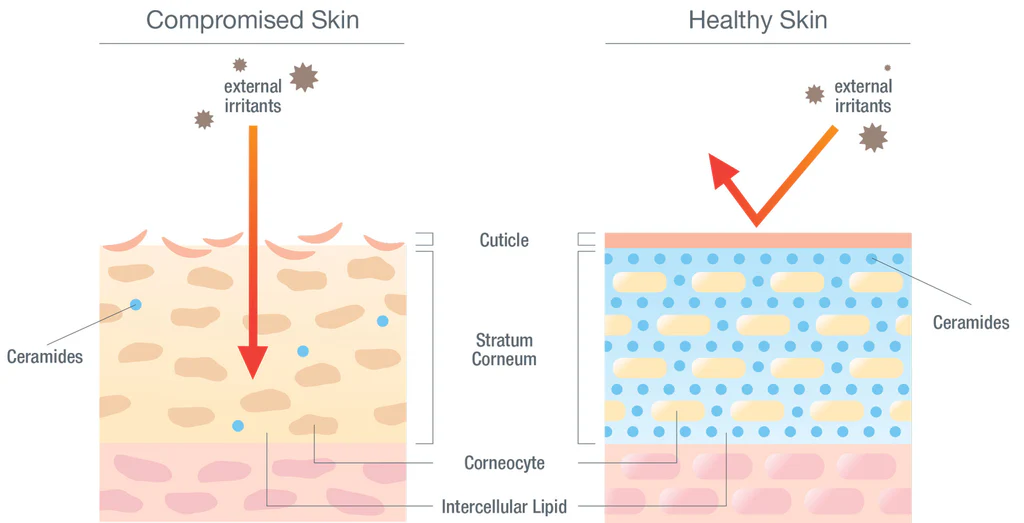
Sensitive skin isn’t “overreacting.”
It simply has a thinner protective barrier, meaning it’s more vulnerable to irritation and bacteria.
That’s why choosing the right technique, and artist, is so crucial.
Your skin needs precision, not pressure.
Which Is Safer for Sensitive Skin: Microblading or Embroidery?
Let’s settle this: for sensitive skin, eyebrow embroidery vs microblading isn’t even a close call.
Eyebrow embroidery is the safer, smarter option.
| Factor | Microblading | Eyebrow Embroidery |
| Pain Level | Higher (blade cuts the skin) | Lower (fine needles, less invasive) |
| Healing Time | 10 to 14 days, often with scabbing | 7 to 10 days, smoother recovery |
| Irritation Risk | Higher, deeper cuts cause more trauma | Lower, controlled depth, minimal tissue damage |
| Pigment Retention | May fade faster on sensitive skin | More stable, longer-lasting |
| Touch-Up Frequency | Every 12 to 18 months | Every 18 to 24 months |
Most dermatologists and brow artists agree, embroidery offers better control for reactive or thin skin because:
- Adjustable needle depth protects the epidermis.
- Machine control reduces pressure and uneven strokes.
- Less tissue trauma = lower infection risk.
- Even pigment distribution means fewer touch-ups (every 18 to 24 months).
With microblading, once the blade goes in, there’s no undoing that stroke.
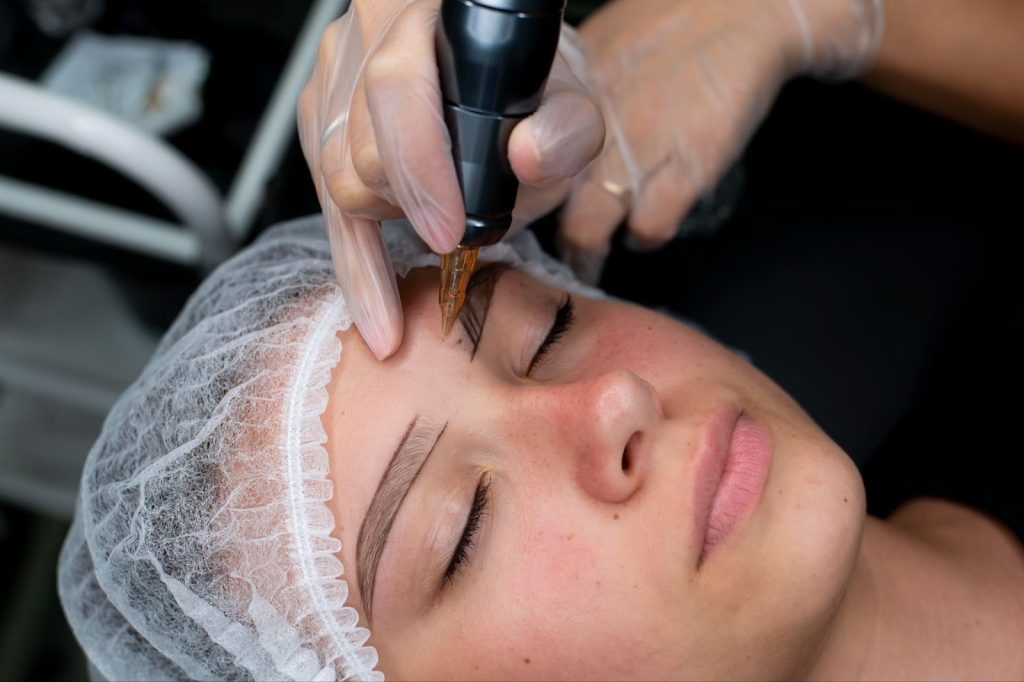
The verdict:
For sensitive or reactive skin, eyebrow embroidery is the safer option.
It uses adjustable nano-needles rather than blades, causes less trauma, heals faster, and retains pigment more evenly.
How to Prepare Your Skin Before the Procedure
- Patch test pigments and numbing cream
- Avoid caffeine, alcohol, and blood thinners
- Moisturize daily with fragrance-free lotion
Even with the gentlest method, preparation makes all the difference.

1. If you have sensitive skin, request a patch test (48 hours prior).
This helps you see how your skin reacts to both the pigment and numbing cream, far better to test a small spot than risk a full reaction.
2. Avoid caffeine and alcohol for 24 hours before.
They thin your blood and can cause more bleeding during the session, making pigment retention harder (University Hospitals).
3. Hydrate your skin daily.
A gentle, fragrance-free moisturizer preps your skin barrier for smoother healing.
Aftercare Tips for Sensitive Skin

- Apply healing balm (no fragrance, no petroleum) 1 to 2× daily.
- Clean gently with lukewarm water, never rub.
- Avoid makeup, sweating, and sun exposure for 10 days.
- Do not scratch, it removes pigment and causes scarring.
- Sleep on your back to prevent friction.
- Avoid actives and harsh products for two weeks, no retinol, acids, or vitamin C.
These small habits can make a big difference in how your brows heal and how long your results last.
Signs of Allergic Reactions to Watch For
Normal healing includes mild redness, slight swelling, light scabbing, and mild itchiness that subsides within days (Healthline).
However, if you experience:
- Redness that spreads past your brows
- Swelling that gets worse after two days
- Yellow crust, pus, or any leaking fluid
- Itchy rash, hives, or a fever
Stop applying products immediately and seek medical attention.
Allergic reactions or infections should never be ignored, early care prevents permanent damage.
Final Thoughts: Choose What’s Right for Your Skin
So, when it comes to eyebrow embroidery vs microblading, sensitive skin always does better with embroidery.
It’s precise, gentle, and designed to minimize trauma while achieving beautifully natural, long-lasting results.
But remember, technique is only half the story.
Your outcome also depends on an experienced artist, proper skin preparation, and disciplined aftercare.
Do your research.
Ask for portfolios showing clients with sensitive skin.
And above all, trust your instincts.
Healthy skin and perfect brows should go hand in hand. With the right approach, you’ll get both.
At SleekBrow, we specialize in gentle, precision-driven techniques designed for every skin type, especially sensitive ones.
If you’re deciding between eyebrow embroidery vs microblading, let our team guide you through a consultation to find what’s best for your skin and style.
FAQs
Can I get microblading or eyebrow embroidery if I have eczema or rosacea?
Only when your skin is stable and cleared by your dermatologist. Eyebrow embroidery is gentler and typically preferred.
How long does eyebrow embroidery last?
18 to 24 months on average; microblading fades faster (12 to 18 months).
Is numbing cream safe for sensitive skin?
Yes, if you have sensitive skin, request for a patch-test 48 hours before treatment.
Can my skin reject pigment?
Rare, but possible. Embroidery distributes pigment evenly, reducing rejection risk.
When can I wear makeup again?
After 10 to 14 days, once all scabs are gone and the skin barrier is intact.
Should I take painkillers before the session?
Avoid aspirin or ibuprofen as they thin the blood. Most artists use numbing cream, so you’ll be comfortable without oral painkillers.
How do I know if my artist is skilled with sensitive skin?
Ask directly and request to see previous work on sensitive-skin clients. A professional will adjust settings, use hypoallergenic pigments, and never push microblading if embroidery is the better fit for you.
